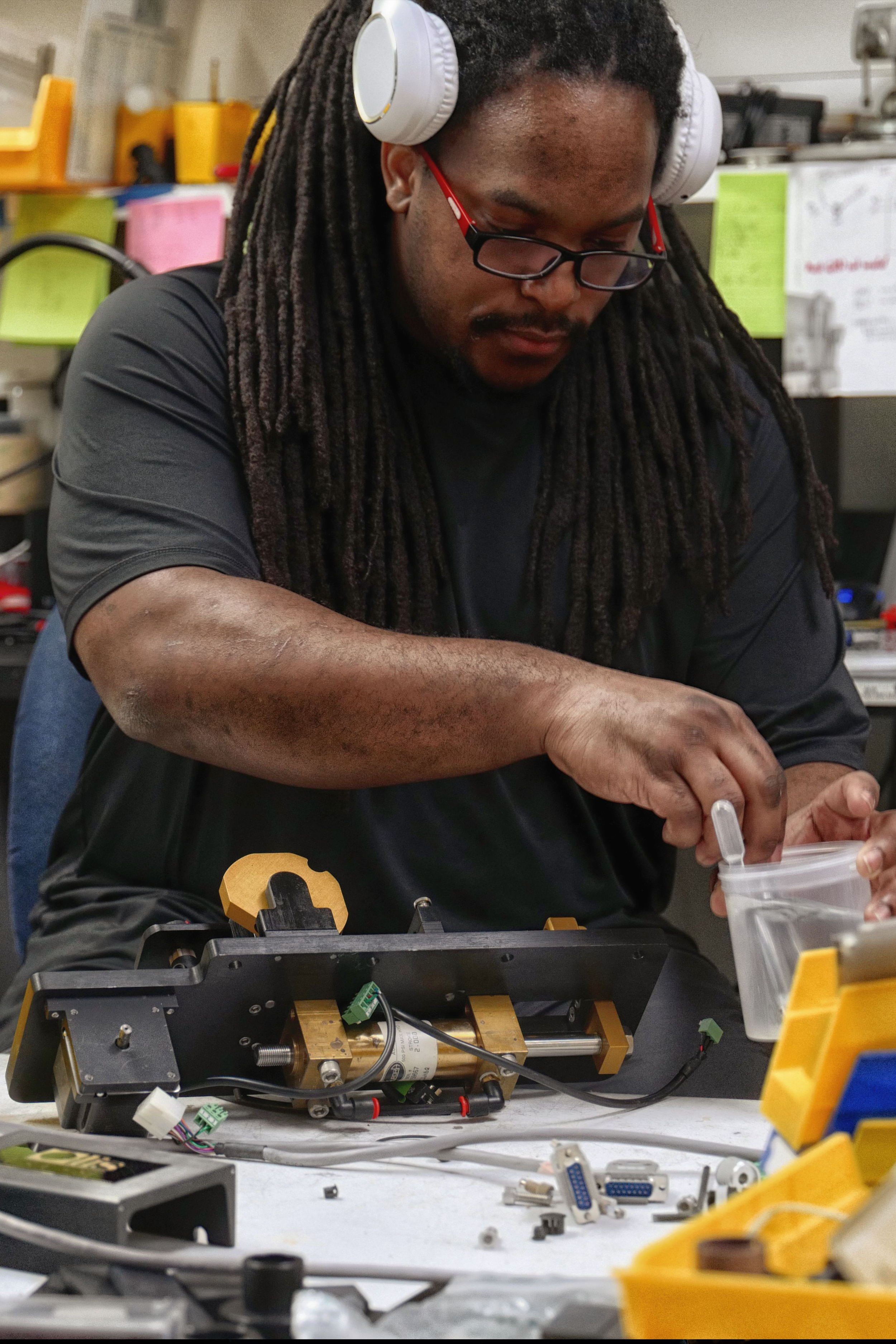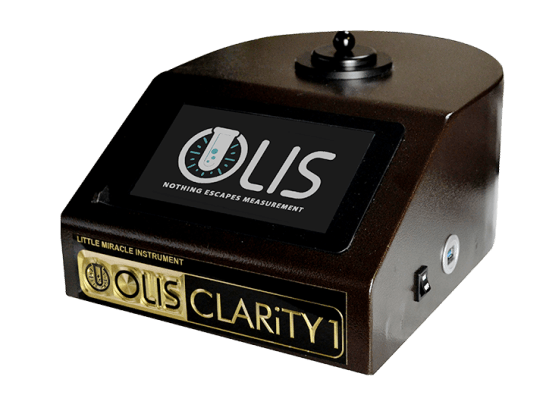The Buzz on Circularly Polarized Luminescence
Wiki Article
Some Known Incorrect Statements About Spectrophotometers
Table of ContentsWhat Does Circularly Polarized Luminescence Mean?Facts About Uv/vis/nir RevealedThe Facts About Uv/vis UncoveredThe Uv/vis StatementsUv/vis Fundamentals ExplainedThe 8-Minute Rule for Circular DichroismThe Single Strategy To Use For Uv/vis10 Simple Techniques For Uv/visUv/vis - TruthsThe Single Strategy To Use For SpectrophotometersWhat Does Uv/vis/nir Mean?4 Easy Facts About Circularly Polarized Luminescence DescribedCircular Dichroism Things To Know Before You Get This
It is then scanned through the sample and the reference solutions. Fractions of the incident wavelengths are transmitted through, or shown from, the sample and the recommendation. The resultant light strikes the photodetector device, which compares the relative strength of the 2 beams. Electronic circuits convert the relative currents into direct transmission percentages and/or absorbance/concentration values.The transmission of a reference substance is set as a baseline (datum) value, so the transmission of all other substances are tape-recorded relative to the preliminary "zeroed" substance. The spectrophotometer then transforms the transmission ratio into 'absorbency', the concentration of specific parts of the test sample relative to the initial substance.
Given that samples in these applications are not readily available in large quantities, they are specifically matched to being examined in this non-destructive method. In addition, precious sample can be conserved by using a micro-volume platform where just 1u, L of sample is needed for total analyses. A quick explanation of the procedure of spectrophotometry consists of comparing the absorbency of a blank sample that does not include a colored substance to a sample that includes a colored substance.
Some Ideas on Circularly Polarized Luminescence You Should Know
In biochemical experiments, a chemical and/or physical residential or commercial property is chosen and the treatment that is utilized is specific to that home in order to derive more info about the sample, such as the amount, purity, enzyme activity, and so on. Spectrophotometry can be used for a variety of methods such as determining optimal wavelength absorbance of samples, identifying optimal p, H for absorbance of samples, determining concentrations of unidentified samples, and figuring out the p, Ka of various samples.: 21119 Spectrophotometry is also a valuable procedure for protein filtration and can likewise be utilized as a method to produce optical assays of a substance.It is possible to know the concentrations of a 2 part mix utilizing the absorption spectra of the standard solutions of each element. To do this, it is needed to know the termination coefficient of this mix at two wave lengths and the termination coefficients of solutions which contain the known weights of the two parts.

Fascination About Uv/vis
Region. The concentration of a protein can be estimated by determining the OD at 280 nm due to the presence of tryptophan, tyrosine and phenylalanine.This method requires a spectrophotometer capable of determining in the UV region with quartz cuvettes.: 135 Ultraviolet-visible (UV-vis) spectroscopy includes energy levels that thrill electronic transitions. Absorption of UV-vis light thrills particles that are in ground-states to their excited-states.
These curves can be used to test a brand-new batch of colorant to inspect if it makes a match to requirements, e
Traditional visible region spectrophotometers area not detect if spot colorant or the base material has product. This can make it hard to handle color concerns if for example one or more of the printing inks is fluorescent. There are 2 significant setups for visual spectrum spectrophotometers, d/8 (round) and 0/45.
Scientists utilize this instrument to determine the amount of substances in a sample. In the case of printing measurements two alternative settings are typically used- without/with uv filter to control better the effect of uv brighteners within the paper stock.
What Does Uv/vis/nir Do?
Some applications require little volume measurements which can be carried out with micro-volume platforms. As explained in the applications section, spectrophotometry can be utilized in both qualitative and quantitative analysis of DNA, RNA, and proteins. Qualitative analysis can be utilized and spectrophotometers are used to tape spectra of substances by scanning broad wavelength regions to determine the absorbance residential or commercial properties (the strength of the color) of the substance at each wavelength.
All About Spectrophotometers
One significant element is the type of photosensors that are readily available for different spectral regions, but infrared measurement is likewise tough because virtually everything releases IR as thermal radiation, particularly at wavelengths beyond about 5 m. Another issue is that numerous products such as glass and plastic absorb infrared, making it incompatible as an optical medium.2013. p. 13. Allen, DW; Cooksey, C; Tsai, BK (Nov 13, 2009). "Spectrophotometry". Recovered Dec 23, 2018. Ninfa AJ, Ballou DP, Benore M (2010 ). Basic Laboratory Methods for Biochemistry and Biotechnology (second ed.). Hoboken: Wiley & Sons. ISBN 9780470087664. OCLC 488246403. Schwedt G (1997 ). The necessary guide to analytical chemistry.
Oke, J. B.; Gunn, J. E.
Not known Details About Circularly Polarized Luminescence

Ninfa AJ, Ballou DP, Benore M (2015 ). Basic Lab Approaches for Biochemistry and Biotechnology (3, rev. ed.). UV/Vis/NIR. Laboratory Devices.
Indicators on Circular Dichroism You Need To Know
"Applied Spectrophotometry: Analysis of a Biochemical Mix". Biochemistry and Molecular Biology Education. Journal of Biochemistry Education.Some Ideas on Circularly Polarized Luminescence You Need To Know
U.S. Department of Commerce National Bureau of Standards special publication; 378. Washington, D.C.: U.S. National Bureau of Standards.The procedure begins with a regulated light source that brightens the analyzed sample. When it comes to reflection, as this light engages with the sample, some is taken in or given off. The produced light journeys to the detector, which is examined, quantified, and presented as industry-standard color scales and indices.
Industry governing bodies normally define specific metrics for specific items, such as Recommended Reading Tomato and Coffee indices. The streamlined mathematics looks like this: Where R is the reflection coefficient. All terms are evaluated over the visible spectrum from 400 to 700 nm. In the case of transmission, when the light connects with the sample, it is either soaked up, reflected, or transmitted.
The Best Strategy To Use For Uv/vis/nir
Examples consist of APHA (American Public Health Association) for watercolor and purity analysis, ASTM D1500 for petrochemical color analysis, edible oil indices used in food, and color analyses of beverages. All terms are examined over the noticeable spectrum from 400 to 700 nm.Image Credit: Matej Kastelic/ Dr. Arnold J. Beckman and his associates at the National Technologies Laboratories first created the spectrophotometer in 1940. In 1935 Beckman established the business, and the discovery of the spectrophotometer was their most ground-breaking development.
The Greatest Guide To Circularly Polarized Luminescence
99% precision. Over time, scientists kept enhancing the spectrophotometer style to boost its efficiency. The UV abilities of the model B spectrophotometer were improved by changing the glass prism with a quartz prism. Ultimately, the Model DU was created, containing a hydrogen light and other enhancements. This instrument was used in industrial laboratories, centers, and chemistry and biochemistry departments.Normally, a spectrophotometer is made up of two instruments, namely, a spectrometer and a photometer. A standard spectrophotometer includes a light source, a monochromator, a collimator for straight light beam transmission, a cuvette to put a sample, and a photoelectric detector.
An Unbiased View of Circular Dichroism
There are various types of spectrophotometers in numerous shapes and sizes, each with its own purpose or functionality. A spectrophotometer identifies just how much light is shown by chemical parts. circular dichroism. It determines the distinction in light strength based upon the overall quantity of light presented to a sample and the quantity of light beam that goes through the sample option
As per the instrument's design, the sample is placed between the spectrometer and the photometer. After the light is passed through the sample, the photometer measures its intensity and displays the reading. A spectrophotometer is used to determine the concentration of both colorless and colored solutes in a service. This instrument is used to identify the rate of a response.
Report this wiki page